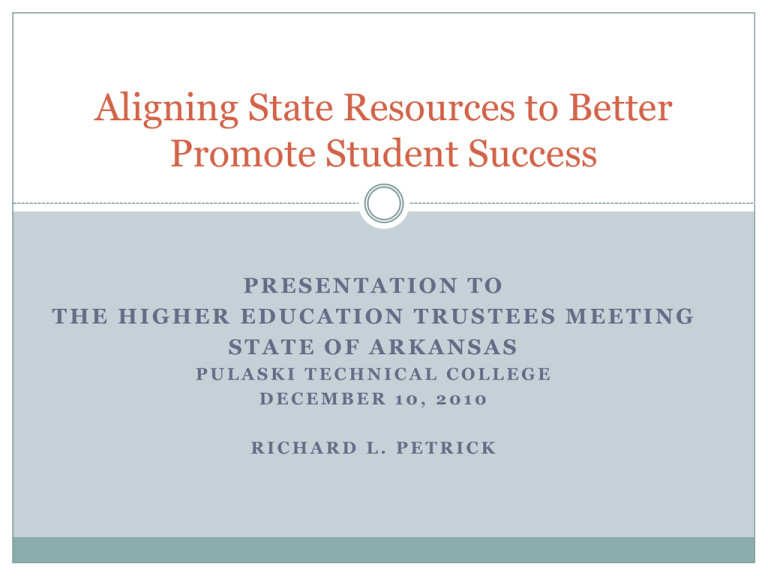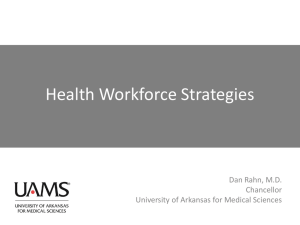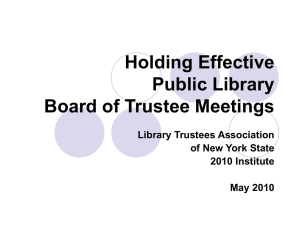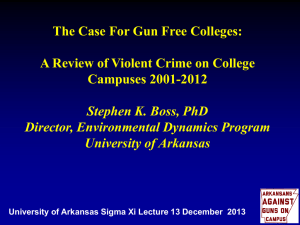Aligning State Resources to Better Promote Student Success
advertisement

Aligning State Resources to Better Promote Student Success PRESENTATION TO THE HIGHER EDUCATION TRUSTEES MEETING STATE OF ARKANSAS PULASKI TECHNICAL COLLEGE DECEMBER 10, 2010 RICHARD L. PETRICK What Is Performance Funding? 2 “ P ERFORMANCE FUNDING IS A METHOD OF FUNDING PUBLIC INSTITUTIONS BASED NOT ON INPUTS, SUCH AS ENROLLMENTS, BUT ON OUTCOMES, SUCH AS RETENTION, DEGREE COMPLETION, AND JOB PLACEMENT…. T HE PRINCIPAL RATIONALE FOR PERFORMANCE FUNDING HAS BEEN THAT PERFORMANCE FUNDING WILL PROD INSTITUTIONS TO BE MORE EFFECTIVE AND EFFICIENT, PARTICULARLY IN A TIME OF INCREASING DEMANDS ON HIGHER EDUCATION AND INCREASINGLY STRAITENED STATE FINANCES. ” CCRC WORKING PAPER #22 Arkansas Trustees Meeting 12/10/2010 Performance Funding: Introduction 3 Why are states turning to performance funding? What are they doing? How can we align incentives with desired results? For institutions, students, faculty, staff? What have we learned from previous efforts? What are the pros and cons of performance funding? What’s happening in Ohio? Arkansas Trustees Meeting 12/10/2010 Performance Funding – Why? The Money Matters FY 2009 Higher Education Revenue Sources Source Amount Note State + local $ $88.7 billion Even with ARRA $ -- no change from FY 2008 Net tuition $44.5 billion Up ~ 7% from FY 2008 Total $133.3 billion Arkansas Trustees Meeting 4 12/10/2010 Performance Funding – Why? The Money Matters FY 2009 Higher Education Revenue Sources Source Amount Note State + local $ $88.7 billion Even with ARRA $ -- no change from FY 2008 Net tuition $44.5 billion Up ~ 7% from FY 2008 Total $133.3 billion Arkansas Trustees Meeting 5 12/10/2010 Performance Funding – Why? The Money Matters “Mounting State Debts Stoke Fears of a Looming Crisis” New York Times December 5, 2010 Arkansas Trustees Meeting 6 12/10/2010 Performance Funding – Why? The Money Matters • Projected state budget gaps: • FY 2011: $121 billion • FY 2012: $102 billion • Post-budget state budget cuts • FY 2008 - $13 billion (13 states) • FY 2009 - $43 billion (43 states) • FY 2010 - $39 billion (39 states) • FY 2011 - $14 billion (14 states) Arkansas Trustees Meeting 7 12/10/2010 Performance Funding – Why? The Degree Matters “Graduation Rates Fall at One-Third of 4-Year Colleges” The Chronicle of Higher Education December 6, 2010 Arkansas Trustees Meeting 8 12/10/2010 Performance Funding – Why? The Degree Matters • The United States is falling behind other countries in educational attainment. • America’s 18 - 24 year-olds are less well-educated than 25-64 year-olds. • Graduation rates are low for 4-year institutions and have not improved over time (58 percent). Arkansas Trustees Meeting 9 12/10/2010 Performance Funding – Why? The Degree Matters • More than 75 percent of students who start at a community college fail to earn a certificate or degree within three years. • U. S. adult learners drop out of college at an alarmingly high rate. • Experts predict a serious shortage of workers with post-secondary degrees and credentials in the near future Arkansas Trustees Meeting 10 12/10/2010 Performance Funding 1.0: 1980 – 2004 Performance Funding 2.0: 2005 – 2010 Arkansas Trustees Meeting 11 12/10/2010 Performance Funding 1.0 v. 2.0 12 Version 1.0 Version 2.0 No national support National support* Individual state State efforts are better experimentation Scattershot evaluation No national clearinghouse connected & focused Stronger evaluations Information accumulating * From multiple Foundations, National Governor’s Association, and US Department of Education Arkansas Trustees Meeting 12/10/2010 Performance Funding 1.0 – Many States Tried It 13 Florida Missouri Oklahoma New Mexico South Carolina Illinois Pennsylvania Washington Ohio Tennessee Arkansas Arkansas Trustees Meeting 12/10/2010 Performance Funding, 1.0 Two examples 14 Tennessee was the first – 1980-81 Piloted in 1974 2 % of the state $ in ‘80, then increased to 5.45% Transparent, focused on few metrics Embedded in the subsidy allocations – not a “bolton” that could be cut when times are bad Relatively simple, flexible Sustained Arkansas Trustees Meeting South Carolina’s experiment – 1990s Very ambitious -- sought to have 100% of funding based on performance Very complex – large number of indicators and processes Threatening – some saw it as a way of shrinking or closing inefficient or ineffective campuses Terminated 12/10/2010 Performance Funding 2.0 15 “We need to measure what matters. We need to know what the students learn, and what jobs they get. We need to know why students of some community colleges do better in the job market than others. Why minority students at some colleges take longer to earn a degree than similar students elsewhere. We don’t know the answers. We’re not even asking the questions.” Bill Gates, 2009 Arkansas Trustees Meeting 12/10/2010 Performance Funding 2.0 16 “Over a third of America’s college students and over half of our minority students don’t earn a degree, even after six years. So we don’t just need to open the doors of college to more Americans; we need to make sure they stick with it through graduation. That is critical. ” President Obama, 2010 Arkansas Trustees Meeting 12/10/2010 The ABCs of Performance Funding – What Do State Policymakers Want? 17 Accountability: - More graduates in high demand fields - More focus on success of underserved populations Better Performance: - Efficient and cost effective instructional delivery focused on completions Collaboration: - Particularly among two and four year institutions Arkansas Trustees Meeting 12/10/2010 The ABCs of Performance Funding – What Do State Policymakers Want? 18 More Cost-efficient Student Success, More Quickly Arkansas Trustees Meeting 12/10/2010 Performance Funding 2.0 19 Some examples: Louisiana (2010 Legislation) Tennessee (2010 Legislation) Indiana Washington Community Technical Colleges Ohio Arkansas Trustees Meeting 12/10/2010 Performance Funding 2.0 20 Louisiana: State funding reductions, more anticipated. For 2010-11, Adopted the GRAD Act that establishes graduation rate goals for public institutions When institutions meet these goals they are granted more fiscal autonomy Tied 25% of state funds to completion/ transfer and articulation/workforce/research, including graduates ages 25 and older, racial/ ethnic minorities, low income, STEM fields Arkansas Trustees Meeting 12/10/2010 Performance Funding 2.0 21 Tennessee: Complete College Tennessee Act of 2010 Comprehensive legislation Outcomes-based funding model, including end of term enrollment, student retention, timely progress toward degree completion, etc. Transfer/articulation – common course numbers Arkansas Trustees Meeting 12/10/2010 Performance Funding 2.0 22 In 2009-10, Indiana modified its funding to include– Degrees (and for low-income students) Course completions On-time graduation, and Transfer Arkansas Trustees Meeting 12/10/2010 Performance Funding 2.0 23 Washington Community/Technical Colleges – The Board established a student success goal Recognized students in all mission areas (including adult basic education and developmental education), reflect diverse communities served by colleges Measures are simple, understandable, and relevant to institution, the student and policy makers Informed by solid research at Columbia University’s Community College Research Center Arkansas Trustees Meeting 12/10/2010 Performance Funding 2.0 24 Washington’s four categories of measures: 1. Momentum points that build towards college-level skills 2. Momentum points that build to “Tipping Point” and beyond 3. Earning college level credits in math 4. Completions Arkansas Trustees Meeting 12/10/2010 Performance Funding – Advantages 25 Institutions do respond to financial incentives Lessons from Performance Funding 1.0 Florida Washington Ohio Tennessee Arkansas Trustees Meeting 12/10/2010 Performance Funding 2.0 – Advantages 26 Opportunity to better align incentives with desired results for: Institutions (state subsidy) Students (financial aid, tuition, instructional delivery) Faculty (tenure/promotion/financial awards) Staff (promotion/financial awards) Arkansas Trustees Meeting 12/10/2010 Performance Funding 2.0 -- Pitfalls 27 Can be difficult to design – need to involve technical expertise early Can be difficult to account for differences in mission Some data are hard to come by Need to recognize funds needed to support institutions’ core functions Could it lead to grade inflation? Arkansas Trustees Meeting 12/10/2010 I. Performance Funding in Ohio, V 1.0 Ohio had a long history of performancebased funding 29 The first of the four “Challenges” began in the 1980s Total funding for the Challenges equaled about 10% of total state operating subsidy for campuses by late 1990s The past successful implementation of performance funding helped set the stage for significant changes in FY 2010 and FY 2011 Arkansas Trustees Meeting 12/10/2010 Performance funding foundations: Policy design 30 The Challenges Goal Recipient Research Increase third-party sponsored research $ Public university main campuses; some private universities ~$10 - $12 million per year Access Lower tuition to increase enrollments at access campuses Public community colleges and selected 4year access campuses ~ $65 million per year Success Decrease time to UG 4 –year degrees; improve degree achievement for at risk students Public university main campuses ~$55 million per year Jobs Increase job-related training Mostly at public twoyear campuses ~$10 million per year Arkansas Trustees Meeting $ Distributed 12/10/2010 Performance funding foundations: Outcomes 31 The Challenges Goal Outcomes Research Increase third-party sponsored research $ Persistent rise in $ volume of third-part sponsored research and state per-capita share of such research. (Source: NSF and related sources) Access Lower tuition to increase enrollments at access campuses High spike in enrollments at access campuses representing what is arguably a net increase in UG enrollments statewide(that is, the access campus enrollments did not come at the price of lowered university enrollments) .(Source: HEI data) Success Decrease time to UG 4 –year degrees; improve degree achievement for at risk students Significant decreased time to degree for UG; slight increase in 6-year degree rates; increase in number of at-risk degree recipients. (Source :HEI data) Increase job-related training Built job training capacity at access institutions; served 5% of Ohio’s workforce annually; significant savings and cost reductions reported by participating businesses and industries. (Source: OBR staff surveys.) 12/10/2010 Jobs Arkansas Trustees Meeting II. Funding Formula Changes in FY 2010 and FY 2011 II. The Chancellor’s ten-year strategic plan: Some key elements 33 Strategic plan was mandated by the legislature Explicit goals for the new public agenda: Enroll and graduate more Ohioans. Increase state aid, improve efficiency, and lower out of pocket expenses for undergraduates. Increase participation and success by firstgeneration students. Increase participation and success by adult students. Each goal has a specific metric by which progress toward the plan is assessed annually. Arkansas Trustees Meeting 12/10/2010 II. Changes in place for FY 2010 and FY 2011 34 Major shift to success-based formulas Creation of three new formulas: University main campuses University regional campuses Community colleges Endorsed by the Governor and approved by the General Assembly in H.B. 1 Arkansas Trustees Meeting 12/10/2010 II. University main campuses 35 Shift from enrollment-based to course- and degree- completion based formula Cost-based course and degree allocations Empirically-based adjustment (extra weighting) for at-risk students Degree-completion component to be phased in slowly Setasides for doctoral and medical funding Doctoral and medical funding to become more dynamic and performance-based Effects phased in over time 99% stop loss in FY 2010 98% stop loss in FY 2011 Arkansas Trustees Meeting 12/10/2010 II. University regional campuses 36 Shift from enrollment-based to course-completion based formula Cost-based course and degree allocations Empirically-based adjustment (extra weighting) for at-risk students Plan to add degree-completion component in 2 to 4 years Time to permit regional campuses to adjust their missions to focus more on upper-level undergraduate enrollments Effects phased in over time 99% stop loss in FY 2010 98% stop loss in FY 2011 Arkansas Trustees Meeting 12/10/2010 II. Community colleges 37 Will continue to have cost-based enrollment formula as major basis of funding Adding State of Washington’s concept of ‘Momentum Points” -- which Ohio calls “Success Points” -- beginning in FY 2011 Success Points share of total community college funding is 5% in FY 2011, and will increase over time Effects phased in over time 99% stop loss in FY 2010 98% stop loss in FY 2011 Arkansas Trustees Meeting 12/10/2010 Toward an integrated state policy in support of student success 38 Goal of public policy Institutions Students Faculty Arkansas Trustees Meeting Major financial policy levers State subsidy Status in Ohio Being implemented, & refined Pilot projects done Student financial aid, & evaluations tuition policy underway Compensation; tenure and promotion policy Not planned 12/10/2010 What we know about successful programs 39 Common threads – staying power Commitment of political leaders, institutional leadership, faculty, staff and students Mission sensitivity -- not every institution is expected to have high performance in every area No funding cliffs -- effects phased in over time Transparency/accountability with periodic reports on results One size does not fit all: Each state approach has been unique, with some sharing of components Improvement focus Institutions should be able to influence the results over a reasonable timeframe Institutions should be able to use the information to develop strategies for improving student achievement Arkansas Trustees Meeting 12/10/2010 Performance and Completion: What can trustees do? 40 Know your campus numbers Know your campus trend line Know how your campus compares to peers Know how your campus compares to top performing peers Know your campus & state context Set specific goals for improvement Use the “C.A.S.E.” method to move the needle Arkansas Trustees Meeting 12/10/2010 Performance and Completion: What can trustees do? 41 What is the “C.A.S.E.” method? Copy And Steal Everything Arkansas Trustees Meeting 12/10/2010 Some sources 42 Books, articles, presentations by: Access to Success (NASH) Brenda Albright (National consultant) Joseph Burke (The Rockefeller Institute) Community College Research Center (Columbia University) Complete College America Bill and Melinda Gates Foundation The Lumina Foundation National Center for Higher Education Management Systems rpetrick@columbus.rr.com (614) 598-9437 Arkansas Trustees Meeting 12/10/2010 Thank You/Questions? 43 Arkansas Trustees Meeting 12/10/2010 Appendix: What are “success points?” 44 Measures of student success that are sensitive to the community college’s mission and students Derived from Columbia University Teacher’s College study One point for each, unweighted by student or program or level Success Points include number of students who either: Complete their first remedial course; Successfully complete a developmental Math course last year, and subsequently enroll in a college level Math; and Successfully complete a developmental English course last year, and subsequently enroll in a college level English. …and who Earn their first 15 semester credit hours Earn their first 30 semester credit hours Earn at least one associate degree, from that institution, in a given year. Complete at least 15 semester credit hours at that institution and subsequently enroll for the first time at a four year college or university, in Ohio. Arkansas Trustees Meeting 12/10/2010








